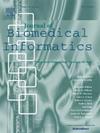Multi-agent norm perception and induction in distributed healthcare
IF 4.5
2区 医学
Q2 COMPUTER SCIENCE, INTERDISCIPLINARY APPLICATIONS
引用次数: 0
Abstract
This paper presents a Multi-Agent Norm Perception and Induction Learning Model aimed at facilitating the integration of autonomous agent systems into distributed healthcare environments through dynamic interaction processes. The nature of the medical norm system and its sharing channels necessitates distinct approaches for Multi-Agent Systems to learn two types of norms. Building on this foundation, the model enables agents to simultaneously learn descriptive norms, which capture collective tendencies, and prescriptive norms, which dictate ideal behaviors. Through parameterized mixed probability density models and practice-enhanced Markov games, the multi-agent system perceives descriptive norms in dynamic interactions and captures emergent prescriptive norms. We conducted experiments using a dataset from a neurological medical center spanning from 2016 to 2020.
The descriptive norm-sharing experiment results demonstrate that the model can effectively perceive the descriptive collective medical norms – which embody the current best clinical practices – across medical communities of varying scales. By contrasting this with the fact that the real descriptive diagnostic practice patterns in the neurological medical center dataset gradually converged over a period of 5 years, we find that the model, through prolonged learning and sharing processes, progressively mirrors the actual descriptive diagnostic trends and collective behavioral tendencies present within the medical community. In the experiment where multiple agents infer prescriptive norms within a dynamic healthcare environment, the agents effectively learned the key clinical protocols within the norm space , which includes control norms, without developing high belief in invalid norms. Furthermore, the agents’ belief update process was relatively smooth, avoiding any discontinuous stepwise updates.

分布式医疗中的多智能体规范感知与归纳。
本文提出了一种多智能体规范感知和归纳学习模型,旨在通过动态交互过程促进自主智能体系统集成到分布式医疗环境中。医学规范系统及其共享渠道的性质要求多智能体系统采用不同的方法来学习两种类型的规范。在此基础上,该模型使代理能够同时学习捕捉集体倾向的描述性规范和指示理想行为的说明性规范。通过参数化的混合概率密度模型和实践增强的马尔可夫博弈,多智能体系统在动态交互中感知描述性规范并捕获紧急规范性规范。我们使用神经医学中心2016年至2020年的数据集进行了实验。描述性规范共享实验结果表明,该模型可以有效地感知不同规模的医疗社区中体现当前最佳临床实践的描述性集体医学规范。通过与神经医学中心数据集中真实的描述性诊断实践模式在5年内逐渐融合的事实进行对比,我们发现该模型通过长期的学习和共享过程,逐步反映了医学界存在的实际描述性诊断趋势和集体行为倾向。在动态医疗环境中,多智能体推断规范性规范的实验中,智能体有效地学习了规范空间H(包括控制规范)内的关键临床协议,而没有对无效规范形成高度信任。此外,代理的信念更新过程相对平滑,避免了任何不连续的逐步更新。
本文章由计算机程序翻译,如有差异,请以英文原文为准。
求助全文
约1分钟内获得全文
求助全文
来源期刊

Journal of Biomedical Informatics
医学-计算机:跨学科应用
CiteScore
8.90
自引率
6.70%
发文量
243
审稿时长
32 days
期刊介绍:
The Journal of Biomedical Informatics reflects a commitment to high-quality original research papers, reviews, and commentaries in the area of biomedical informatics methodology. Although we publish articles motivated by applications in the biomedical sciences (for example, clinical medicine, health care, population health, and translational bioinformatics), the journal emphasizes reports of new methodologies and techniques that have general applicability and that form the basis for the evolving science of biomedical informatics. Articles on medical devices; evaluations of implemented systems (including clinical trials of information technologies); or papers that provide insight into a biological process, a specific disease, or treatment options would generally be more suitable for publication in other venues. Papers on applications of signal processing and image analysis are often more suitable for biomedical engineering journals or other informatics journals, although we do publish papers that emphasize the information management and knowledge representation/modeling issues that arise in the storage and use of biological signals and images. System descriptions are welcome if they illustrate and substantiate the underlying methodology that is the principal focus of the report and an effort is made to address the generalizability and/or range of application of that methodology. Note also that, given the international nature of JBI, papers that deal with specific languages other than English, or with country-specific health systems or approaches, are acceptable for JBI only if they offer generalizable lessons that are relevant to the broad JBI readership, regardless of their country, language, culture, or health system.
 求助内容:
求助内容: 应助结果提醒方式:
应助结果提醒方式:


